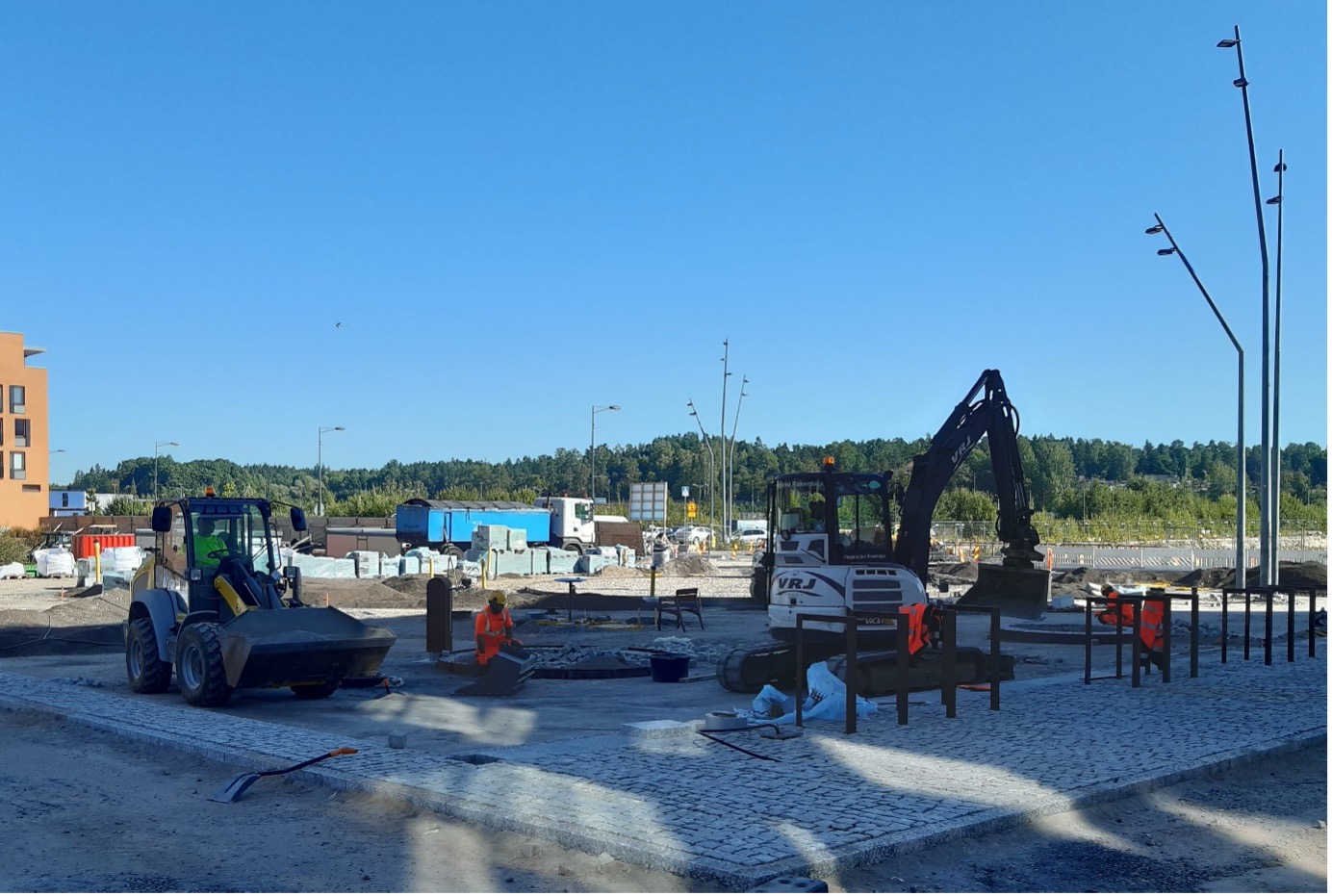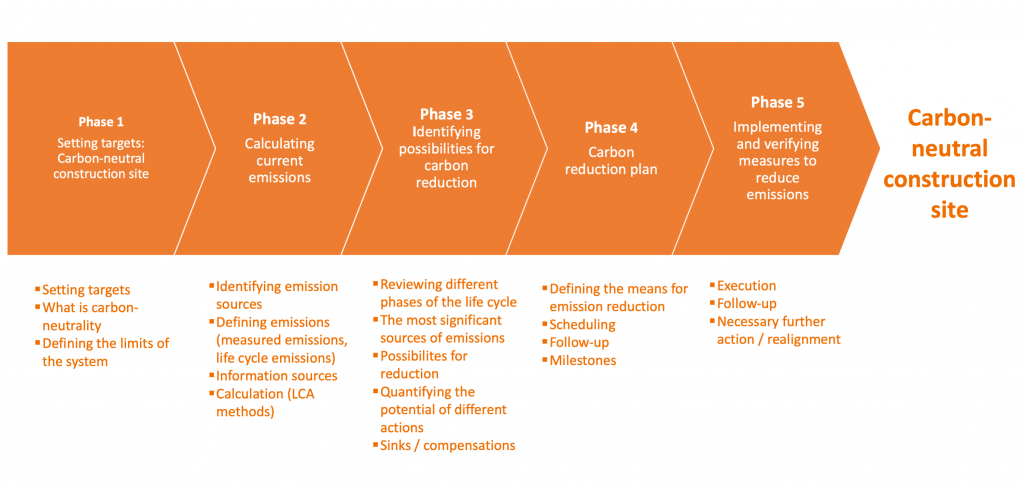
How can we calculate the carbon footprint of a construction site?

Construction site carbon footprint calculations
construction site, carbon footprint, greenhouse gas emissions, climate change mitigation, sustainability, building and construction, life cycle assessment
The success of the efforts to reduce emissions from the construction site of the Lukutori square in Espoo was evaluated through a carbon footprint assessment. Measures taken on the site were found to have had a significant impact on emission reduction: emissions from the construction of the Lukutori square were 25% of the emissions from a traditional construction site. The assessment can be used to set targets for the effective reduction of carbon footprint on construction sites and to define the measures that must be taken. It also makes it possible to examine emissions in a comprehensive manner and helps identify the most critical processes in terms of emission reduction goals.
- A comprehensive examination: the majority of emissions were caused by emissions other than direct emissions from the construction site, which is why the project also took into account emissions from materials and energy production;
- −75%: thanks to the measures to reduce emissions from the Lukutori construction site, its emissions were 25% of the emissions from a traditional construction site;
- savings: in the Lukutori project, the biggest savings were achieved through the use of Finnish rocks instead of rocks imported from China. Another significant factor was replacing fossil fuel-powered heavy machinery and equipment with electric machinery and equipment.
This solution is right for you if
- you work in the procurement or construction division of a local authority; or
- you manage or represent a construction company and you are looking for new low-emission solutions.
BASIC FACTS
Project party: VTT Technical Research Centre of Finland Ltd.
Contractor: VRJ Rakennus Oy
Pilot site: Lukutori square, Espoo
Time frame: 6/2020–11/2020
Emission calculations provide information about the area’s carbon footprint
The term carbon footprint is used to describe the total greenhouse gas emissions caused by a product, activity or service. It tells us how much greenhouse gas emissions are generated during the life cycle of a product or service. When net greenhouse gas emissions are reduced, the carbon footprint of the activity becomes smaller. In a carbon-neutral society, the amount of greenhouse gas emissions released into the atmosphere by the society is the same as the amount it can capture, meaning that its net carbon footprint is zero. To be able to determine if an activity is carbon neutral, we must assess its carbon footprint throughout its entire life cycle.
Emissions calculations can be based on production or consumption. Production-based emissions calculations examine the emissions generated in a certain area, and this method is typically used to calculate the amount of emissions caused by different countries. The consumption-based approach, on the other hand, examines emissions caused by the manufacture, transport and disposal of the products or services produced and consumed, for example, by a certain community or area over a specific period of time. In the calculation of emissions from an industrial area, the consumption-based method produces more meaningful results and it is also widely used. As such, the calculations for this project were also made using the consumption-based approach.
Towards emission-free construction sites with carbon footprint calculations
The concept of carbon-neutral construction sites is divided into five phases, which are: 1) setting targets; 2) calculating current emissions; 3) identifying possibilities for carbon reduction; 4) drawing up the carbon reduction plan; and 5) implementing and verifying measures to reduce emissions.

In phase 2, the project team used the Greenhouse Gas Protocol1, which is one of the world’s best-known and widely used calculation methods. In the calculation, emissions were divided into three scopes:
- Scope 1: direct greenhouse gas emissions, which are generated as a result of a company’s activities on site, or physically in its offices and production facilities.
- Scope 2: indirect emissions from the generation of purchased energy, or emissions caused by the production of electricity, heating and cooling used by the company (if electricity is produced off site and the company buys it).
- Scope 3: indirect greenhouse gas emissions that are caused by the company’s activities. Indirect emissions are known as “upstream emissions”, which are the emissions that are caused by the manufacture of the products the company uses in its production processes and/or the emissions caused by the use and disposal of these products.

Impact of the concept on carbon neutrality and resource wisdom in the industrial area
Emissions from the pilot site were calculated using the method described above. The calculations covered the following aspects:
- Fuel consumption of heavy machinery and equipment and fuel production
- Emissions from transport, including fuel production
- Electricity production and batteries for electric heavy machinery and equipment
- Production of electricity consumed elsewhere on the site
- Materials used on the site
- Dry concrete
- Growing medium
- Rocks
- Crushed stone
- Cube-shaped paving stones
To illustrate the relative significance of the emission reduction measures implemented on the Lukutori site, the project team compared two different scenarios in the calculation: the actual situation of Lukutori and a made-up comparison scenario, in which no solutions to reduce greenhouse gas emissions had been implemented. The comparison scenario was based on three assumptions: all heavy machinery was powered by fossil diesel fuel (the consumption of electric heavy machinery was calculated based on the horsepower and operating hours of equivalent machinery), the electricity used was the equivalent of an average Finnish electricity network, and the stone materials were imported from China.

The results showed that the greenhouse gas emissions caused by the Lukutori construction site were approximately 90 tonnes of CO2 equivalent, while emissions in the comparison scenario amounted to 360 tonnes. In other words, the emissions in the comparison scenario were about four times as high as the emissions from the Lukutori site. In the Lukutori project, the biggest savings were achieved through the use of Finnish rocks instead of rocks imported from China. Another significant factor was replacing fossil fuel-powered heavy machinery and equipment with electric machinery and equipment.
Since the Lukutori site was relatively small and the project duration short (approximately six months), concept phases 4 and 5 were not included in the pilot project. During these phases, the project team would have examined possibilities for emission reduction, drawn up a plan to implement and monitor these possibilities and prepared a closing report detailing how well the goals were achieved. Implementing the concept not only provides a set of tools to reduce emissions from an ongoing site, but also ideas and instructions for implementing low-emission alternatives on future construction sites.
TAKE-HOME MESSAGES
- It is important to assess emissions in a comprehensive manner.
- Attention should be paid to the ambitiousness of emission reduction targets and actions.
- Significant emission reductions can be achieved by also taking materials into account.
- In addition to purchased materials, switching to electric heavy machinery and equipment is also an essential strategy to reduce emissions.




